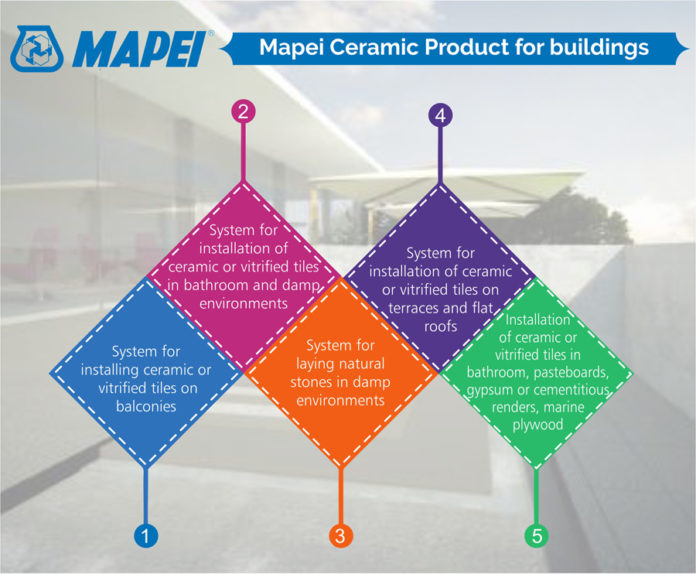Ceramic tiles, natural stone and recomposed materials are generally used for floors and coatings in residential, commercial and industrial constructions and in airports, swimming pools, etc. In recent years, the development of new technology for the production of ceramic tiles has led to new, thinner and larger sized tiles being available on the market, which are used to create almost continuous surfaces with extremely high architectural value. Also, the increasing demand to improve soundproofing and thermal insulation in buildings, means that tiles must now be laid on substrates with different characteristics than those normally used. We must also stress how our awareness of the quality of the air and surroundings in our homes and in the workplace has developed in recent years.
MAPEI research has undertaken the challenge to address these demands and has developed products with increasingly sophisticated formulations which are easy to use and apply, guarantee the durability of ceramic and stone flooring and coatings and respect the environment and the health of floor layers, and all those who use the environments in which they have been applied.
MAPEI can now boast a complete range of products adapted to all installation systems, on any scale. The range includes cementitious adhesives, paste adhesives, hydraulic binders for screeds, primers, levelling compounds, grouts, sealants and ancillary products suitable for applications until recently considered technically impossible but that now open up a number of exciting new possibilities:
- Repair work without costly demolition;
- Increased speed and efficiency in the execution of work. As a result, work is completed more rapidly;
- Progressive elimination of dangerous products from construction sites;
- Grouts and joints that are not only functional, but may also serve as decorative features;
- Systems for the installation of ceramic tiles on facades on layers of thermal insulation (Mapetherm Tile System).
How to choose the right adhesive?
When installing ceramic tiles, the adhesive is used to create a strong durable bond between the files and the filing substrate. To choose the most suitable adhesive, the specific requirements of each project (the are where the tiles are installed, service conditions when in use, type of substrate, dimensions of the tiles, etc) and any installation constraints (installation schedule, installation technique etc.) must all be taken into consideration. MAPEI proposes a vast range of adhesives which are classified according to EN 12004 or ISO 13007-1 standards, based on the following criteria:
- Chemical composition:
- Cementitious (C) adhesive made from a mixture of hydraulic binders, aggregates and chemical additives. They may be either a one-component type, which means they just need to be blended with water, or a two-component type, which means they are blended with water and / or latex
- Dispersion (D), a mixture of organic binders dispersed in water polymers with organic additives
- Reactive (R), a mixture of synthetic resins which harden through a chemical reaction (component A and B).
- Adhesion Capacity:
- Class 1: Normal adhesives
- Class 2: Improved adhesives
- Optional Classes:
- Class F: Fast setting adhesives
- Class T: Reduced slip adhesives
- Class E: Adhesives with extended open time
- Class S1: deformable adhesives (for cementitious adhesives only)
- Class S2: highly deformable adhesives (for cementitious adhesives only)
For more information, visit www.mapei.co.in

